Dunes types and formation
-
Duck Commander
- Golden Member

- Posts: 0
- Joined: Wed Dec 08, 2010 2:09 pm
Guys here is some information I collected from web and love to share with you,,,, it will help us all to understand dunes and understand how to drive there.:011:
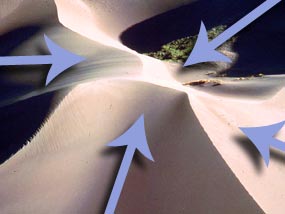 NPS/GREAT SAND DUNES NPP
NPS/GREAT SAND DUNES NPP
Star dunes have three or more arms, formed from multiple wind directions.
Star Dunes
Where star dunes are present, an area's wind regime is complex. Star dunes form only in places where wind blows from varied directions over the course of a year.
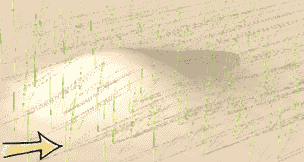 NPS/DAVID ZELENKA
NPS/DAVID ZELENKA
Animation showing the formation of a parabolic dune.
Parabolic Dunes
Much of the sand sheet is covered with vegetation. If strong winds erode a section of the vegetated sand (commonly referred to as a blowout), a parabolic dune may form. Leeward motion occurs if sand from the blowout is deposited on the opposite slope of the parabolic dune. Vegetation holds the "arms" of the dune in place as the leeward "nose" of the dune migrates forward toward the main dunefield. Parabolic dunes are common in the sand sheet southwest of the main dunefield.
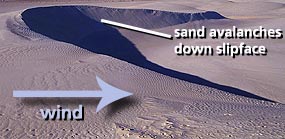 NPS/PATRICK MYERS
NPS/PATRICK MYERS
Barchan ("BAR-kahn") dunes form in areas with only one wind direction, and little or no vegetation.
Barchan Dunes
If conditions were "perfect"—the landscape was flat, winds blew from only one direction, vegetation could not grow, and sand was available but limited —barchan dunes would dominate a sandscape. Since those conditions are rarely found at Great Sand Dunes, a very complex dune system emerges. Even so, classic barchan dunes can be found at various locations throughout the park. Look for classic barchan dunes directly across from the main Dunes Parking Area. As the sand supply increases, barchan dunes begin to connect with others forming barchanoid ridges. If the ridges become fairly straight, scientists call them transverse dunes (below).
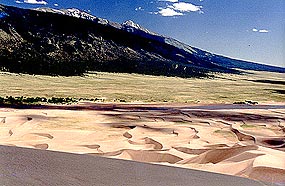 Transverse Dunes
Transverse Dunes
Barchan dunes (above) can become aligned together along a plane perpendicular to the wind. If the line becomes somewhat straight, dune scientists refer to these forward marching ridges as transverse dunes. They progress forward as their leeward slipfaces release sand one avalanche at a time.
NPS/PATRICK MYERS
Barchan dunes along Medano Creek can eventually align and join into long ridges called transverse dunes.
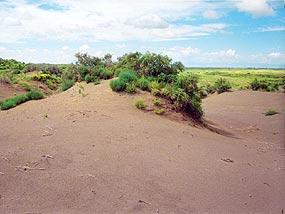 NPS/ANDREW VALDEZ
NPS/ANDREW VALDEZ
Nebkha or Coppice Dunes
Nebkha dunes (also known as coppice dunes) are simple dunes that form around vegetation, primarily on the sand sheet. Clumps of shrubs and grass begin to gather windblown sand; as the sand gets deeper, the plants also grow taller, allowing mo
Enjoy
 NPS/GREAT SAND DUNES NPP
NPS/GREAT SAND DUNES NPPStar dunes have three or more arms, formed from multiple wind directions.
Star Dunes
Where star dunes are present, an area's wind regime is complex. Star dunes form only in places where wind blows from varied directions over the course of a year.
 NPS/DAVID ZELENKA
NPS/DAVID ZELENKAAnimation showing the formation of a parabolic dune.
Parabolic Dunes
Much of the sand sheet is covered with vegetation. If strong winds erode a section of the vegetated sand (commonly referred to as a blowout), a parabolic dune may form. Leeward motion occurs if sand from the blowout is deposited on the opposite slope of the parabolic dune. Vegetation holds the "arms" of the dune in place as the leeward "nose" of the dune migrates forward toward the main dunefield. Parabolic dunes are common in the sand sheet southwest of the main dunefield.
 NPS/PATRICK MYERS
NPS/PATRICK MYERSBarchan ("BAR-kahn") dunes form in areas with only one wind direction, and little or no vegetation.
Barchan Dunes
If conditions were "perfect"—the landscape was flat, winds blew from only one direction, vegetation could not grow, and sand was available but limited —barchan dunes would dominate a sandscape. Since those conditions are rarely found at Great Sand Dunes, a very complex dune system emerges. Even so, classic barchan dunes can be found at various locations throughout the park. Look for classic barchan dunes directly across from the main Dunes Parking Area. As the sand supply increases, barchan dunes begin to connect with others forming barchanoid ridges. If the ridges become fairly straight, scientists call them transverse dunes (below).
 Transverse Dunes
Transverse DunesBarchan dunes (above) can become aligned together along a plane perpendicular to the wind. If the line becomes somewhat straight, dune scientists refer to these forward marching ridges as transverse dunes. They progress forward as their leeward slipfaces release sand one avalanche at a time.
NPS/PATRICK MYERS
Barchan dunes along Medano Creek can eventually align and join into long ridges called transverse dunes.
 NPS/ANDREW VALDEZ
NPS/ANDREW VALDEZNebkha or Coppice Dunes
Nebkha dunes (also known as coppice dunes) are simple dunes that form around vegetation, primarily on the sand sheet. Clumps of shrubs and grass begin to gather windblown sand; as the sand gets deeper, the plants also grow taller, allowing mo
Enjoy
-
Gorgin4325
- Moderator

- Posts: 0
- Joined: Tue Dec 27, 2011 8:04 pm
- Been thanked: 2 times
Great info.
We need to ask Wikipedia to add Eggs Basket to the list lol
We need to ask Wikipedia to add Eggs Basket to the list lol
-
zeemmee
- Newbie

- Posts: 0
- Joined: Thu Dec 29, 2011 12:41 pm
Thanks to DC for this post, cause i was planning to post my self one similar to this.
Have a look at this book

Couple days back Saw this book & was compelely blown away by the contents, Its old publication of 2009 - or 10 as i may recall.
Every SAND- DESERT person must either see this or own this book.Arial photography at its BEST
What DC MENTIONS about star dunes is right & there is one place on earth where they exist in brotherhood - LIWA.
The link http://wikimapia.org/#lat=19.6366647&lo ... 14&l=0&m=b
Sadly its on the Saudi & yemen border.Unfortunately the Liwa we dwell on is to tiny to describe its amazing contents.
There more types of dunes as mentioned by George Steinmetz cant remember all of them But yes Star dune are of the most beautiful shapes Dubai has super bowl which is a good example. Apart from these there are Migrating dunes ( Hell yes ) they look mini monsters ready to catch a weary driver.
The Most scary is the sinkhole in wadi Al Ghiran - Again Liwa of saudi arabia. In movies such as lawrence of arabia we get to see the sinkhole though its a mere representation of the desert wilderness I believed it as fiction & American viewpoint.Since then I was in search of an ACTUAL SAND Sinkhole, never Found one until I saw one in the book.
Have a look at this book

Couple days back Saw this book & was compelely blown away by the contents, Its old publication of 2009 - or 10 as i may recall.
Every SAND- DESERT person must either see this or own this book.Arial photography at its BEST
What DC MENTIONS about star dunes is right & there is one place on earth where they exist in brotherhood - LIWA.
The link http://wikimapia.org/#lat=19.6366647&lo ... 14&l=0&m=b
Sadly its on the Saudi & yemen border.Unfortunately the Liwa we dwell on is to tiny to describe its amazing contents.
There more types of dunes as mentioned by George Steinmetz cant remember all of them But yes Star dune are of the most beautiful shapes Dubai has super bowl which is a good example. Apart from these there are Migrating dunes ( Hell yes ) they look mini monsters ready to catch a weary driver.
The Most scary is the sinkhole in wadi Al Ghiran - Again Liwa of saudi arabia. In movies such as lawrence of arabia we get to see the sinkhole though its a mere representation of the desert wilderness I believed it as fiction & American viewpoint.Since then I was in search of an ACTUAL SAND Sinkhole, never Found one until I saw one in the book.






